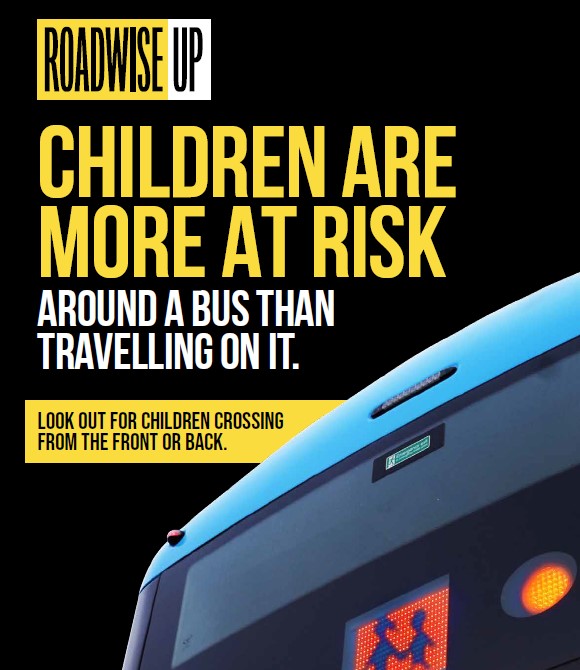
Buses are very large vehicles so drivers trying to overtake them must take extra care to avoid posing danger to themselves or to
other road users. Children getting on or off a bus taking them to and from school are particularly vulnerable around buses.
Children can be very easily distracted or take actions which are totally unexpected. Therefore, drivers need to take extra care
when passing a parked or stationary bus as children may unexpectedly appear from the front or back of the bus to attempt to cross the road.
Drivers should be aware that school buses in rural areas may make multiple stops and not always at an assigned bus stop.
The children getting off these buses may need to cross to the opposite side of the road. As the bus will obscure your view,
it is safer to remain stationary behind the bus until it moves off.
As many school uniforms are dark in colour, it may be very difficult to see children getting on or off a bus attempting to cross the road,
so drivers should take extra care during the darker winter mornings and evenings.
Drive slowly around schools; the speed limit around many of our schools is a maximum 20 mph.
Rules for drivers
Drivers, always pay extra attention around buses – where there are buses, there will be pedestrians. When waiting to overtake or driving
past a bus, particularly a school bus, remember that pedestrians and school children are likely to be waiting to get on or will have got
off and be about to cross the road. Slow down and only pass the bus when you are sure it is safe to do so.
Drive carefully when passing a stationary bus carrying school children or showing ‘School Bus’ markings or signs as children may be
getting on or off, Highway Code Rule 209.
Give priority to buses, coaches and trams when you can do so safely, especially when they signal to pull away from stops.
Look out for people getting off a bus or tram and crossing the road,
Highway Code Rule 223.
Overtaking buses and large vehicles
Before starting to overtake a bus, ensure that if you were to proceed, you would have enough time to complete your overtaking manoeuvre.
Remember that it takes longer to pass a larger vehicle, so if you’re unsure what’s coming in the opposite direction,
or how long it would take you to move ahead, it’s safer to stay where you are.
Large vehicles can block your view. Your ability to see and plan ahead will be improved if you pull back to increase your separation distance,
Highway Code Rule 222.
Leave a gap if the car in front of you is attempting to overtake; they may have misjudged and need to drop back if they run out of time or room.
The best advice is to drop back further from the vehicle you’re considering overtaking, which will increase your ability to see further ahead
- as well as help to ensure that the driver of the large vehicle can see you in their mirrors. See
Highway Code Rule 164.
If you are following a large vehicle, such as a bus or articulated lorry, be aware that the driver may not be able to see you in the mirrors.
Be prepared to stop and wait if it needs room or time to turn,
Highway Code Rule 221.
Blind spots
Awareness of blind spots is essential. Take extra care around buses and other large vehicles,
because their blind spots are larger. Be aware that the driver may not be able to see you. If you’re in the driver’s blind spot, he/she is blind to you:
as a pedestrian, as a motorist, as a motorcyclist or as a cyclist.
Drivers remember, that because a bus is so large, a child around a bus may not see you approaching and for the same reason you may not see a
child emerging from the front or back of the bus to cross the road. Always take extra care around stationary buses, especially school buses.
#RespectEveryonesJourney
Follow us on Facebook, X and Instagram for daily road safety advice and Highway Code Rules.